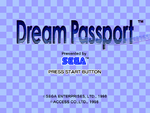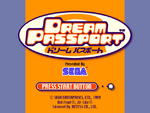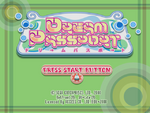| Compilance
|
Screenshot(s)
|
Pass/fail
|
Comments
|
| 3.2: Upon booting software, the stereo/monaural output setting should be changed to match the boot ROM.[11]
|
| Immediately upon loading an application (before the Title Loop starts), the stereo/monaural output setting should be changed to match the Boot ROM settings of the Main Unit. Even if sound output is not listed in Chapter 9, Options, an application internally determines if it is stereo or monaural, so the settings must be changed to correspond to the Main Unit Boot ROM settings on the application side. Currently, the stereo/monaural output settings are saved on the Main Unit, and should not be saved under any circumstances to the memory card. Refer to Chapter 9.2, Storing Option Settings, for more details.
|
|
|
Untested, assumed pass
|
|
| 5.1.1: Upon boot, the Sega license logo must appear on screen (and if utilising Windows CE, the Windows CE logo).[12]
|
| As soon as power is turned on, the Sega License Logo display must appear on the screen. In titles developed using Windows CE for Dreamcast, the Microsoft logo must appear along with the Sega License Logo (see the following screen shot). To display these two logos simultaneously, enable both "Sega License Logo" and "Microsoft Logo" on your application disc's IP.BIN file.
|
|
|
Untested, assumed pass
|
|
| 5.2.6: Any other logo screens must occur after the Sega license logo, and should be visible for at least two seconds.[13]
|
| After the Sega License logo is displayed, display any other logo screens. Display each screen for at least two seconds.
|
|
|
Untested, assumed pass
|
|
| 5.2.7: License and middleware logos should observe the standards outlined in the contract document in Chapter 24[14]
|
| To display the license logo and library logo, observe the following standards:
1. Follow the rules outlined in the contract document regarding the content of logo display.
2. The order of logo display and the possibility of skipping screens is defined in the terms of the contract document.
3. To display the library logo, refer to Chapter 24, License Acknowledgment when Using Libraries and Patents
4. When you need to display a license logo that is not regulated in the related contract document, we recommend you prepare a detailed display of the contents and send it to the Sega Legal Department for consultation to avoid possible problems of rights infringement.
|
|
|
Untested, assumed pass
|
|
| 5.2.8: The use of team or series logos must be approved by license holders and Sega's legal department. Do not use the words "Presents", "Presented by" or "Produced by" to avoid complications of rights ownership.[14]
|
| To display a team logo and series logo, observe the following standards:
1. When creating a team logo or series logo, obtain approval for its use and register the trademark.
2. When using the logo, use only the logo in A. When using the logo, attach detailed specs of the logo display for the parties involved and send it to the Sega Legal department.
3. Obtain approval from the company in charge of the logo.
4. When displaying the logo, do not use the words "Presents", "Presented by" or "Produced by" together with the team or series logo to avoid complications of rights ownership.
|
|
|
Untested, assumed pass
|
|
| 5.2.9: OEM logos must be approved by Sega's legal department. "In cooperation with" must be added to the OEM company name.[15]
|
| When displaying OEM logos other than manufacture and sales permit licensers, these are the standards to follow:
1. When you want to display an OEM logo, the logo display content is regulated in the development contract document.
2. If there is no regulation in the contract document, as a principle, any OEM logo display is disallowed.
3. However, even with the conditions of (2.), when absolutely necessary, logos can be displayed by attaching detailed specs of the logo display for the parties involved and bringing it to the Sega Legal Department. The OEM company name is displayed in the main position, with the logo display in the secondary position.
• Add "In cooperation with"… to the display area of the OEM company name.
|
|
|
Untested, assumed pass
|
|
| 6: A title screen must display a title logo and the text "PRESS START BUTTON" (or for non-English software, a term that signifies that pressing START will start a game. Copyright information must also be displayed unless specified otherwise by the contract document, or there is not enough space.[16]
|
| The Title Screen displays the Title Logo, "PRESS START BUTTON" and a copyright, unless specified otherwise by contract document or difficulty (such as a movie title) to display the copyright because of lack of space. If "PRESS START BUTTON" is displayed in any language other than English, express the idea that pressing the start button will start the game as simply as possible.
|
|
|
Untested, assumed pass
|
|
| 6.1: If the transition past the title screen is not initiated by user input, display the title screen for about two seconds.[16]
|
| If transition to the next screen is not initiated by user input, display the Title Logo for about two seconds.
|
|
|
Untested, assumed pass
|
|
| 6.1.1: Advancing past the title screen should only occur when START is pressed.[16]
|
| Advancing to the Main Game or Start/Option screen should occur only when the START button is pressed at the Title Screen. If the START button is not pressed, proceed to the next screen of the title loop after a short time has elapsed, as mentioned in Chapter 3, Sequences before Game Start.
|
|
|
Untested, assumed pass
|
|
| 7.1: During the demo sequence, "PRESS START BUTTON" and/or "DEMO PLAY" must be displayed on screen to distinguish the demo from normal play.[17]
|
| During the Play Demo sequence, "PRESS START BUTTON," and/or "DEMO PLAY," should be displayed on the screen to clearly distinguish from the main game (after game start).
|
|
|
Untested, assumed pass
|
|
| 7.2: Pressing START during a demo sequence should return to the title screen.[17]
|
| Pressing the START button during either the Play Demo or Story Demo should immediately bring up the Title Screen. If the START button is not pressed, end the demo after a short time has elapsed, and proceed to the next screen of the title loop.
|
|
|
Untested, assumed pass
|
|
| 8.1: Any menus must exist separately from the title screen.[18]
|
| The Start/Option Selection screen exists separately from the Title Screen. If a "Menu" selection such as Start/Option is needed, it should appear when the START button is pressed at the Title Screen. Objects other than the Menu can be used and combined as needed.
|
|
|
Untested, assumed pass
|
|
| 8.2: Menu items should always be shown, even if the controller state means they cannot be used. When items cannot be used, (e.g. versus mode, when only one controller is connected) they should be greyed out.[18]
|
| According to the controller connection state, items that are unusable should be displayed in the menu, but not be selectable. If a second controller is not present, "vs" mode should be grayed out. If the phone line is not plugged in, the network selection should be grayed out.
|
|
|
Untested, assumed pass
|
|
| 9.1: A stereo/monaural audio setting should be provided.[19]
|
| Considering the many users who play on monaural TVs, the Stereo/Monaural selection should be provided whenever possible.
|
|
|
Untested, assumed pass
|
|
| 9.2: The stereo/monaural setting must not be saved. The default setting is saved in the boot ROM.[20]
|
| If the option settings are to be backed up according to the above, the Stereo/Monaural setting should not be saved. On the Sega Dreamcast, the Stereo/Monaural settings are saved in the Main Unit, considering the case where the same data is to be used to play in another environment.
|
|
|
Untested, assumed pass
|
|
| 9.3: If the stereo/monaural setting is changed in-game, the boot ROM setting must be changed too.[20]
|
| When the user changes the value of the voice output setting on the application option screen, the Main Unit Boot ROM setting should also be set to the same value before the option screen is exited. Wait until the user confirms. As used in the procedures of 3.1, 9.2 and 9.3, the Stereo/Monaural setting refers to Main Console setting, and other option settings refer to the saved data (if present).
|
|
|
Untested, assumed pass
|
|


